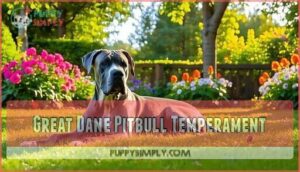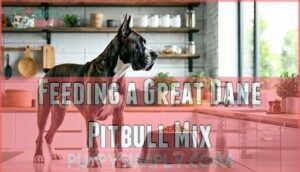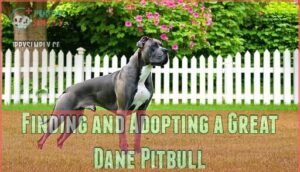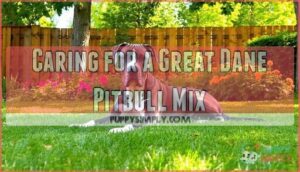This site is supported by our readers. We may earn a commission, at no cost to you, if you purchase through links.
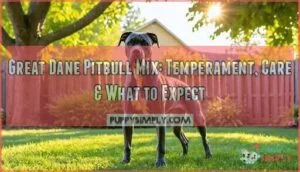
What makes this mix especially fascinating is how it challenges stereotypes about both parent breeds. The Great Dane’s calm, friendly nature pairs with the Pitbull’s often-misunderstood loyalty and trainability to create a companion that’s both protective and affectionate.
But potential owners should know this: this isn’t a dog for casual pet owners. The Great Dane Pitbull mix requires significant commitment—from early socialization and consistent training to meeting their high exercise needs and managing the costs of a large, energetic breed. If you’re considering bringing one of these impressive dogs into your home, it’s important to understand exactly what you’re taking on.
Table Of Contents
- Key Takeaways
- Introducing The Great Dane Pitbull Mix
- What Does a Great Dane Pitbull Look Like?
- Great Dane Pitbull Temperament
- Exercise Needs for a Great Dane Pitbull
- Grooming Requirements
- Feeding a Great Dane Pitbull Mix
- Health and Lifespan
- Finding and Adopting a Great Dane Pitbull
- Caring for a Great Dane Pitbull Mix
- Frequently Asked Questions (FAQs)
- Conclusion
Key Takeaways
- The Great Dane Pitbull mix (Great Danebull) typically stands 24-30 inches tall and weighs 60-100 pounds, combining the Great Dane’s calm elegance with the Pitbull’s athletic loyalty—but they need 60-120 minutes of daily exercise split into two sessions to prevent destructive behaviors and maintain joint health.
- Early socialization and consistent positive reinforcement training are non-negotiable for this intelligent hybrid, as their protective instincts and size require structured guidance to develop into well-adjusted companions rather than overwhelming challenges.
- These dogs face serious inherited health risks including bloat (affecting 37% of mature Great Danes), hip dysplasia, dilated cardiomyopathy (41% of giant breeds), and various genetic disorders—making twice-yearly vet visits and controlled growth during puppyhood critical for longevity in their typical 8-12 year lifespan.
- Adoption through breed-specific rescues costs $100-300 and requires careful vetting including home visits and yard requirements, but potential owners must also verify local breed legislation since some municipalities restrict "pit bull type" dogs that may include Great Danebulls.
Introducing The Great Dane Pitbull Mix
Ever wondered what happens when you mix the gentle giant of the dog world with one of its most misunderstood powerhouses? Meet the Great Danebull—a hybrid that’s changing what we think makes a family dog truly outstanding.
You’ve got two breeds here with wildly different street cred but personalities that mesh better than you’d expect.
Designer dogs haven’t been around long, but the Great Danebull is already flipping the script on what we thought we knew about both parent breeds.
For families looking for a loyal companion with protective instincts and affectionate devotion, this hybrid offers something special. Yes, owning one can be pricier—large breeds eat more and need bigger everything—but what you get is a dog that bonds strongly with its family and thrives in active homes ready to embrace both its strength and its surprising tenderness.
What Does a Great Dane Pitbull Look Like?
The Great Danebull is no ordinary mixed breed—it’s a striking combination that turns heads wherever it goes.
These dogs blend the Pitbull’s muscular build with the Great Dane’s towering frame, creating a unique look that’s both powerful and elegant. Here’s what you can expect from their physical appearance.
Size
Thinking about a Great Dane Pitbull Mix? Size matters—a lot. These dogs vary considerably depending on which parent they take after:
- Weight Factors: Most adults weigh 60 to 100 pounds, though some reach 120 pounds
- Height: Expect 24 to 30 inches at the shoulder
- Growth Patterns: Full size develops around 12-18 months
- Body Proportions: Long, lean frames with muscular builds
Space Requirements matter—this giant breed needs room to thrive. Owners should research dog care tips to make sure they can provide the necessary space and attention for their Great Dane Pitbull Mix.
Coat and Markings
Your Great Dane Pitbull mix’s coat is like a genetic lottery—you might end up with a sleek, shiny finish or a slightly thicker covering, depending on which parent’s genes dominate. Coat colors range widely—black, white, fawn, brindle, blue, and red—sometimes appearing as a single color, sometimes blended into striking patterns. The hair texture is usually short and dense, making shedding manageable all year.
Grooming Advice for your Great Danebull:
- Brush weekly to spread natural oils and remove loose fur
- Use a damp cloth between baths to keep that glossy look
Great Dane Pitbull Temperament
If you’re wondering what it’s like to live with a Great Dane Pitbull mix, their temperament tells you everything. These dogs blend the gentle giant personality of the Great Dane with the loyal, spirited nature of the Pitbull—creating a companion that’s both affectionate and surprisingly protective.
Let’s break down what makes them tick—and how to bring out their best.
Friendly Yet Protective
Think of this mix as your shadow with teeth—devoted to a fault, yet scanning every room like a seasoned bouncer. Your Great Dane Pitbull Mix bonds intensely with family, displaying loyalty and training potential that’s honestly impressive. They’re wired for family protection, reading canine body language intuitively and alerting you to anything unusual. Those protective instincts don’t mean aggression; with good socialization, you’ll raise one of the most intelligent dogs around—a temperament that balances guardian with gentle giant. Understanding dog behavior genetics is key to nurturing a well-rounded and gentle companion.
- Melting into your lap despite weighing 80 pounds
- Watching the front door with quiet, confident awareness
- Playing tug-of-war with your kids, then switching to gentle mode instantly
- Following you room-to-room, because you’re their whole world
Training Needs
Start with positive reinforcement—this mix thrives when you reward good behavior with treats, praise, or play. Owners report a 78% success rate in basic obedience training within six months, proving these dogs learn quickly.
Early socialization prevents anxiety and helps your pup adapt to new environments, people, and pets. Clicker training works well for behavioral modification, especially since they’re keen to please.
Avoid punishment-based methods; they backfire with sensitive, intelligent dogs. Consistent training and socialization build the confident, well-mannered companion you’re after.
Exercise Needs for a Great Dane Pitbull
Most people underestimate the exercise demands of a Great Dane Pitbull Mix. These dogs need 60 to 120 minutes of daily activity, ideally broken into two sessions to protect their joints and reduce bloat risk.
Skimp on this, and you’re setting yourself up for chewed furniture, an overweight pup, and one very antsy dog trying to work off pent-up energy.
A balanced daily routine should include:
- Structured walks twice daily (20-40 minutes each) to establish rhythm and mental calm
- High-intensity play sessions like fetch or agility work for adults with fully developed bones
- Water-based activities such as swimming to aid joint health while satisfying their need for movement
- Indoor enrichment on bad weather days—puzzle feeders and interactive toys keep energy levels in check
Match exercise formats to your dog’s age and adjust caloric intake accordingly. Puppies need gentler, shorter sessions to avoid growth plate damage, while adults thrive on vigorous activity that challenges both body and mind.
Grooming Requirements
Good news—grooming a Great Danebull won’t eat up your life. Their short, dense coat keeps maintenance simple, though you’ll still need to stay on top of a few basics.
Here’s a quick look at what bathing, brushing, and nail care involve for this breed.
Bathing
Your Great Danebull’s bath routine doesn’t need to be complicated—think of it as a quick reset for their coat, not a full spa day.
Many Great Dane Pitbull mixes only need a bath every 6-8 weeks, unless they’ve gotten into something messy. Use lukewarm water and a gentle, pH-balanced dog shampoo—oatmeal formulas are great for sensitive skin.
After rinsing off all the soap, towel-dry or use a low-heat dryer to keep them warm.
Brushing
Brushing your Great Danebull weekly is like hitting the reset button—it keeps their short coat sleek, spreads those natural oils around, and catches loose hair before it decorates your furniture.
What works best for coat care:
- Use a rubber curry brush or soft bristle brush for effective shedding control
- Brush in the direction of hair growth to prevent irritation
- Weekly brush frequency is usually enough for this low-maintenance canine companion
- Add extra sessions during seasonal shedding to manage increased hair loss
- Check for any skin issues while brushing your Great Dane Pitbull Mix
This simple routine promotes dog health and makes dog grooming feel less like a chore.
Nail Care
Think of your dog’s nails like your own—when they get too long, every step becomes uncomfortable, and that clicking sound on hardwood floors is your first warning sign. Regular claw health checks boost overall dog health and comfort.
For your Great Dane Pitbull Mix, trimming nails every three to four weeks keeps paw maintenance on track and prevents nail fungus or splitting. You’ll want quality clippers or a grinding tool for this dog pedicure—whichever your canine companion tolerates best.
Feeding a Great Dane Pitbull Mix
Feeding your Great Danebull isn’t just about filling a bowl—it’s about fueling a powerhouse that needs good nutrition to stay strong and healthy. These large, active dogs have specific dietary needs that change as they grow, and getting it wrong can lead to serious health issues later on.
Here’s what you need to know about nutrition and meal timing to keep your gentle giant thriving.
Nutrition
A dog this big needs more than a full bowl—you’re feeding an athlete that torches calories at a serious pace.
What your Great Danebull needs depends on their age, how active they are, and their own metabolism, so their diet should match their specific energy demands.
Watch for food allergies that can trigger skin irritation or digestive upset:
- Pick high-quality protein sources (chicken, beef, fish) as the foundation of dog nutrition
- Balance fats and carbohydrates to promote joint health and sustained energy
- Avoid fillers and artificial additives that compromise dog health and wellness
Responsible pet care means consulting your vet about meal portions and feeding schedule to prevent bloat—a life-threatening concern in deep-chested breeds.
Meal Schedule
Here’s the thing about timing—it’s not just what you feed your Great Dane Pitbull Mix, but when. Get it wrong, and you’re looking at a trip to the emergency vet.
These dogs have deep chests, which makes them prime candidates for bloat, a life-threatening condition. The fix? Split their daily food into two or three smaller meals instead of dumping it all in the bowl at once.
Puppies require four feedings until six months, then shift to three meals, finally settling into twice-daily feeding by their first birthday. This portion control approach backs a balanced nutrient intake while reducing gastric torsion risk.
Never free-feed—structured mealtimes protect your dog’s health and strengthen your bond through consistent care routines that honor their unique dietary needs.
Health and Lifespan
Like most giant breeds, your Great Dane Pitbull mix won’t be with you as long as you’d hope. But understanding what to expect can help you make the most of every year together.
Size plays a huge role in longevity, and this crossbreed faces some inherited health risks you’ll want to watch for. We’ll explore what research says about their typical lifespan and the conditions that commonly affect them.
Lifespan
A Great Dane Pitbull mix typically lives 7 to 14 years, with most landing in the 8-12 year range.
These dogs age faster than smaller breeds—their size puts extra wear on their joints, heart, and overall system.
Genetic factors play a huge role—what they inherit from each parent can tip the scales toward better longevity or higher mortality rates. You can help their health by staying ahead of potential health risks through regular vet visits and keeping them at a healthy weight.
Thoughtful care throughout their life—quality nutrition, consistent exercise, and early intervention when something feels off—can help them thrive for as long as possible.
Health Issues
Your Great Dane Pitbull mix faces some serious dog health issues you can’t ignore. Hip dysplasia hits up to 7% of Great Danes, and heart conditions like dilated cardiomyopathy affect a staggering 41% of giant breeds—making regular cardiac monitoring non-negotiable.
Watch for these canine health red flags:
- Bloat (gastric dilatation-volvulus), a life-threatening emergency affecting 37% of mature Great Danes
- Genetic disorders including hypothyroidism (7-13% prevalence) and von Willebrand disease
- Cancer risks, especially osteosarcoma in their long bones
- Allergies and skin conditions, present in 16% of mixed breeds with Pitbull ancestry
- Wobbler syndrome, a spinal disorder more common in giant crosses
Twice-yearly vet visits catch problems early. Your vigilance—paired with quality nutrition and controlled growth during puppyhood—gives your Great Dane Pitbull mix the best shot at beating the odds.
Finding and Adopting a Great Dane Pitbull
You’ll find mixed-breed dogs like the Great Dane Pitbull mix (often called a Great Danebull) listed at rescue groups specializing in large breeds or general dog adoption centers. Organizations like Upper Midwest Great Dane Rescue accept Pitbull Great Dane crosses, not just purebreds, broadening your options. Start with Pet Adoption and Rescue networks in your area.
The adoption process usually involves an application, reference checks, a mandatory home visit, and contract signing—expect two to four weeks from start to finish. Many rescues require a fenced yard and proof your current pets are vaccinated and spayed or neutered. Adoption fees run $100–$300, covering basic veterinary care.
Before committing, check local breed legislation. Some municipalities restrict ‘pit bull type’ dogs, which may cover your Great Danebull. Responsible rescues offer post-adoption help—training resources, behavioral guidance, and return guarantees if things don’t work out. Many also coordinate foster care placements first, letting you test compatibility before finalizing.
Caring for a Great Dane Pitbull Mix
A Great Danebull isn’t a low-maintenance companion. These smart, energetic dogs need real commitment—regular exercise, mental stimulation, and someone who understands their emotional side.
Three things matter most when raising a healthy, well-adjusted Great Dane Pitbull mix.
Training
Training your Great Danebull is like guiding raw power into a partnership. Without good guidance, their impressive intelligence and size can quickly turn everyday situations into overwhelming challenges.
Start with puppy classes and positive reinforcement to teach obedience commands, socialization skills, and housebreaking early on. Your dog’s eagerness to please makes behavioral correction easy, but consistency is key to turning that gentle giant into your well-adjusted companion.
Exercise
Your Great Danebull thrives on movement—without it, that boundless energy transforms into destructive boredom faster than you’d expect.
Commit to 1-2 hours of daily walking, running exercises, and playtime activities like fetch or tug-of-war. Mix outdoor games with mental stimulation puzzles to keep your large breed dog engaged.
For young pups, moderate intensity protects developing joints—then gradually amp up as they mature. This isn’t just dog care; it’s your partnership’s foundation.
Overall Care
Taking on a Great Danebull means you’re in it for the long haul—this isn’t a casual commitment.
It’s about weaving care into your everyday life: staying alert to their needs, keeping routines consistent, and showing real affection.
You’ll plan a diet suited to their size, schedule regular vet check-ups, and set up a living space with enough room.
Focus on early socialization, keep up with training, and prepare for emergencies.
This all-around approach keeps your Great Dane Pitbull Mix healthy and protects your investment in their care.
Frequently Asked Questions (FAQs)
What are common nicknames for the Great Dane pitbull mix?
This powerful crossbreed answers to several names: Great Danebull, Danebull, American Bull Dane, or Pit Dane mix.
Whether you call them a Pitbull Great Dane hybrid or American Dane, you’re describing the same loyal companion—a striking fusion of two iconic breeds that brings devotion and presence into your home.
Are Great Dane Pitbulls good with other pets?
Pet socialization greatly influences household dynamics. With early training and effective canine communication, Great Dane Pitbull mixes can live harmoniously with other family pets in multi-pet homes.
However, it’s still important to supervise introductions to ensure a smooth and safe integration.
How much does a Great Dane Pitbull puppy cost?
Puppy prices from dog breeding operations vary widely. A Great Dane Pitbull mix from reputable breeders usually costs $500 to $1,500, while adoption fees through rescues range from $150 to $
These prices reflect breed demand and health screenings.
Do Great Danebulls bark or howl frequently?
Like a quiet guardian who speaks only when necessary, Great Danebulls don’t usually bark or howl excessively. Their vocalization tends toward purposeful communication—alerting you to visitors or expressing needs—rather than constant noise.
Good dog training helps shape these barking patterns into manageable communication styles.
What are the best activities for Great Danebulls?
High-energy dogs thrive with interactive playtime ideas like fetch, tug-of-war, and agility courses. Outdoor adventures, such as hiking, keep them engaged, while puzzle toys provide mental stimulation.
Regular dog socialization and energy release activities through structured dog training help large breed dogs channel their enthusiasm productively.
Conclusion
The truth is, the Great Dane Pitbull mix isn’t for everyone, and that’s okay. This hybrid requires more than average commitment—intensive training, consistent exercise, and genuine dedication to socialization.
The Great Dane Pitbull mix demands serious commitment, but rewards the right owner with unmatched loyalty and gentle strength
But for the right owner, you’ll gain a loyal companion who blends elegance with strength. If you’re ready to meet their needs, a Great Dane Pitbull mix can fill your home with affection, protection, and surprising gentleness that defies both breeds’ stereotypes.
- https://a-z-animals.com/animals/pit-bull/pit-bull-facts/pit-bull-and-great-dane-mix/
- https://www.dogster.com/dog-breeds/great-dane-pitbull-mix
- https://articles.hepper.com/great-danebull/
- https://www.akc.org/expert-advice/health/great-dane-life-span/
- https://www.reddit.com/r/rescuedogs/comments/1cf8uuf/does_5001000_adoption_fee_at_a_5013c_rescue_ran/



